Los Mineros, Guanajuato 1790, Carlos IV : Restructuring of Patterns and Varieties
by Alejandro Martínez Bustos
Within the theme of proclamation medals of the Spanish kings in the New World, we have had great numismatic authors since the 19th century who have classified these pieces to pass on to us an orderly record of the pieces in which the facts and events were perpetuated concerning each Spanish king within his colonies in America. Fonrobert, HerreraAdolfo Herrera, Medallas de Proclamaciones y Juras de los Reyes de España, Madrid, Spain, 1882., MedinaJosé Toribio Medina, Medallas de Proclamaciones y Juras de los Reyes de España en América, Santiago, Chile, 1917., RosaAlejandro Rosa, Aclamaciones de los Monarcas Católicos en el Nuevo Mundo, Buenos Aires, Argentina, 1895 and Monetario Americano, Buenos Aires, Argentina, 1892, Pérez MaldonadoCarlos Pérez Maldonado, Medallas de México -Conmemorativas, Monterrey, México, 1945 and GroveFrank W. Grove, Medals of Mexico Vol. I, Medals of the Spanish Kings, First Ed., California, USA, 1970 and .Second Ed., California, USA, 1976 (among many others) were the main researchers and investigators in describing this great compendium of stories that are coined in medals that we enjoy today. All those publications were dedicated and tireless according to the possibilities of each author to approach large public and private collections. From all of them a small clue can be obtained to contribute new conclusions, and the simple passage of more than 130 years gives us a factual experience in terms of availability of information and particularly by e-media in which we have information and auction results by doing a click without the necessity to travel. Undoubtedly, in the future there will be someone who can contribute more elements and/or conclusions to this present reclassification of the medal of the Miners, Guanajuato, (henceforth described as “Los Mineros”) that I am trying to create as best as possible with all the documentation I have found . Let us begin with a summary of the historical antecedent that gave rise to what will be discussed in the following investigation.
The Gazata de México dated 10 May 1791 contains the list of the festivities celebrated on the occasion of the swearing of the oath.
This act ended with throwing to the People quantity of the gold, silver and copper coins that had been minted with this design, and … proceeded to the second act of the Proclamation from the stage of the Plazuela de San Pedro de Alcántara, having received the distinguished Corps of Mining, represented by its Deputies and Electors, who in their turn with equal generosity and joy threw into the joyful crowd an excessive number of the coins that for this purpose they ordered to be minted for their part of the same metals with the Bust of His Majesty. and characteristic figures of the Noble Corps that dedicated them, and the silver basins that contained them, the result of which was the repetition of general cries of victory and acclamations.
… having arrived at the Chapter House, the third act was celebrated on its magnificent stage with the same solemnity and pomp as in the others, returning to throw to the people quantity of coins, in which the portrait of the monarch was engraved on the obverse, and on the reverse the arms of the city, and after the act repeating the cheers and acclamations
…
From the same Royal Houses and with the same order, the City Council and the entire retinue accompanying the Marquis Alferez Rea went to his house at six o'clock in the afternoon, where they were served a splendid general refreshment, with so much variety of ice cream, fruits, cakes and composition of exquisite flowers, … and to better perpetuate the memory of such a plausible day distributed to the audience many medals of gold, silver and copper which in turn were minted with the bust of the king and the arms of his nobility, …Gazata de México, Tomo IV, Núm. 33, 10 May 1791. The original text is "Guanaxuato 12 de Abril.
Relacion de las solemnes funciones con que celebró esta N. C. la Proclamacion del Señor DON CARLOS IIII.
…
Terminóse este acto con arrojarle al Pueblo cantidad de las Monedas de oro, plata y cobre que se habían acuñado con este designio, y volviéndose á ordenar la ilustre Comitiva, se procedió al segundo acto de la Proclamacion en el Tablado de la Plazuela de San Pedro de Alcántara, habiéndolos recibido el distinguido Cuerpo de la Minería representado por sus Diputados y Electores; quienes á su tiempo con igual generosidad y júbilo arrojaron al alborozado concurso número excesivo de las Monedas que para este efecto mandaron acuñar por su parte de los mismos metales con el Busto de S. M. y figuras características del Noble Cuerpo que las dedicaba, y las palanganas de plata que las contenían; cuya resulta fué la repeticion de los generales victores y aclamaciones.
Ordenado de nuevo el Paseo, y habiendo llegado á las Casa Capitulares, se celebró en su magnífico Tablado el tercer acto con la misma solemnidad y pompa que en ,los otros, volviéndose á arrojar al Pueblo cantidad de Monedas, en que staba gravado por el anverso el Retrato del Monarca, y por el reverso las Armas de la Ciudad, y terminado el acto repitiéndose los vivas y aclamaciones, quedó allí expuesto el Real Pendon por tres dias consecutivos con la correspondiente Guardia, y por las noches con la séria iluminacion de trescientas achas de cera, que repartidas con bella simetria entre la multitud de candílejas que adornaba toda la fachada, presentaban un golpe de luz tan extraordínario que emulaba las claridades del dia.
Desde las mismas Casas Reales y con igual órden, acompañando el Ayuntamiento y toda la Comitiva al Señor Marqués Alferez Real, se dirigieron á su Casa á las seis de la tarde, donde se les sirvió un expléndido general refresco, con tanta variedad de helados, frutas, masas y composicion de exquisitas flores, que dió que admirar aun a los Sugetos del mas delicado gusto; y para mejor perpetuar la memoria de tan plausible dia distribuyó á los Concurrentes muchas Medallas de oro, plata y cobre de las que por su parte se acuñaron con el Busto del Rey y las Armas de su Nobiliario, de las que á su tiempo se dirigieron á SS. MM. Real Familia y Ministerio con las de la Ciudad y Minería los correspondientes iuegos, acomodados en caxitas de madera forradas en terciopelo, y adornadas de exquisitos broches de plata y oro.".
The Marquis of San Juan de Rayas said: “…at the end of that act, a large number of medals were thrown to the people of the town on three occasions, apart from the medal that was distributed on my behalf…”, extracting the relevant information as follows: - The local Council or Cabildo in a letter dated 19 January 1791, described the day of the Proclamation Ceremony on 27 December 1790, in it states “to which he sent to the Court a gold medal, two in silver and two in copper”: in another letter addressed to the King, the Royal Ensign (Alférez Real), Marques de San Juan de Rayas, Don José Ma. de Sardaneta y Legaspi, dated 22 June 1791, with the same purpose, said the following: “I had gold, silver and copper medals opened in Mexico at my expense, to perpetuate the memory of this joy”, and another addressed to the Minister Porlier in which he added that: “put aside the royal busts of SS.MM. and on the other the arms of my house with the corresponding inscriptions” …”
The aforementioned was described by Carlos Pérez Maldonado in his book Medallas de México -ConmemorativasCarlos Pérez Maldonado, op. cit., p.102. This excerpt was included after cataloging the medal of Los Mineros in Pérez Maldonado’s book and not after the one actually referred to in the letter of the Cabildo dated 19 January 1791, which Pérez Maldonado catalogued as No. 106 (Grove C-78), the los Mineros medal (Grove C-75), being the only one of the two which is known to have been struck in gold. In addition, it is worth considering the medal with the Guanajuato coat of arms, cataloged by Carlos Pérez Maldonado under No. 104 and 105 (Grove C-72, C-73 and C-74), which finally refers to the act of proclamation “held” on 25 December 1790 (although the official document described above states that this act was performed on 27 December 1790). Thiis medal is also not known in gold, which strengthens the fact that these three medals (the Los Mineros, Marques de Rayas and Proclamation of 25 December 1790), were distributed in the same act.
Once the historical framework that gave rise to this medal is described, I can point out that this is a highly accurate medal characterized by its complex, detailed and attractive reverse design made by Master Gerónimo Antonio Gil, and which is generically reported with the following three obverses:
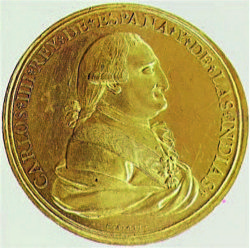 1. INDIAS obverse
1. INDIAS obverse
CARLOS † IIII † REY † DE † ESPAÑA † Y † DE † LAS † INDIAS †
Previously cataloged as Grove C-75, Medina 166, Herrera 144 – Cayón 144ª,
Rosa 113. Fonrobert 6824, Pérez-Maldonado 107.
Main Differences:
Signed G.A. GIL.
Short ponytail (coleta corta)
Wearing the Band of the Grand Cross of the Order of Carlos III and the Order of the Golden Fleece.
48 specimens of los Mineros medal were identified with this obverse in the different metals and finishes cataloged by Frank W. Grove and other authors consulted for this investigation.
This obverse corresponds to a Puebla Medal dated 17 January 1790, cataloged by Frank W. Grove as C-126 and in addition to the los Mineros medal, this obverse was subsequently used in Grove C-74 - Guanajuato Proclamation medal dated 25 December 1790; and C-201 - San Miguel el Grande Proclamation medal of 1791.
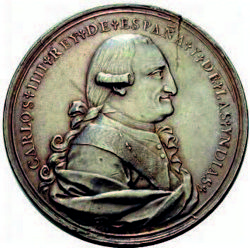 2. YNDIAS obverse
2. YNDIAS obverse
CARLOS † IIII † REY † DE † ESPAÑA † Y † DE † LAS † YNDIAS †
Previously cataloged as Grove C-76, Medina 167, Herrera uncataloged –
Cayón 144Juan R. Cayón and Carlos Castán. Monedas Españolas, desde los Visigodos hasta el quinto Centenario del descubrimiento de América, Décima Ed., Madrid, España, 1992, Rosa uncataloged, Fonrobert uncataloged, Betts Plate 4, No. 11Benjamin Betts. Some Undescribed Spanish-American Pieces, New York, USA, 1898, available in the USMexNA online library.
Main Differences:
Signed GIL
Long pontail (coleta larga)
Wearing the Band of the Grand Cross of the Order of Carlos III WITHOUT the Order of the Golden Fleece.
It is to be considered that the workload was so great for the year 1790 (a year in which more than 68 medals were issued, apart from those that are obviously presumed to be made locally such as that of Chihuahua (Grove C-54) and those of Guatemala ( Grove C-80 to C-87), New Mexico (Grove C-90), and those of Pátzcuaro (Grove C118-120)) that it is unlikely that the dies for events held in January 1790 had been prepared at the same time as those that were intended for an event to be held in October of the same year. The workload was such that it is feasible to have dies in such a way in advance of the act that it was necessary to issue certain medals. In some cases, the bust dies were reused for other proclamation medals for other acts and places.
This obverse corresponds to a Puebla medal cataloged by Frank W. Grove as C-125 and was damaged in the issue of these Puebla medals. it is enough to relate the photograph from the Frank W. Grove book to confirm this: consequently, all the Los Mineros medal with this bust present the aforementioned damage.
Abundant in time regarding the use of this obverse die, it can be seen that it was once again used for the execution of the proclamation medal of San Miguel el Grandet, dated 1791, cataloged by Grove as C-202 and is not a surprise that all of these pieces are clearly identified by the die break across the reverse that has been discussed.
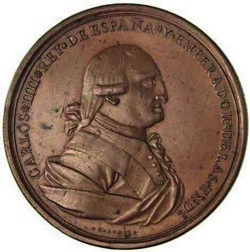 3. YNDs obverse
3. YNDs obverse
CARLOS * IIII * REY * DE ESPAÑA * Y * EMPERADOR * DE LAS * YNDs.
This obverse corresponds to a Puebla Medal dated 17 January 1790, cataloged by Frank W. Grove as C-127.
Previously cataloged as Grove C-76.5, Medina uncataloged, Herrera uncataloged, Rosa uncataloged, Fonrobert uncataloged.
Main Differences:
Signed *G*A*GIL*
Sort ponytail
Wearing the Band of the Grand Cross of the Order of Carlos III WITHOUT the Order of the Golden Fleece. Four button jacket.
I did not locate any other medal with this obverse for Los Mineros, just the one in bronze cataloged by Grove, in the second edition of his book published in 1976, under Grove 76.5, which belonged to his collection. This was later sold by Superior Galleries at its auction dated 11 June 1986, lot 678 in which it was wrongly described as Grove C-75c “with die break across reverse”.
In addition to the Los Mineros medal, this obverse was subsequently used in the following medals: Grove C-73 -Guanajuato Proclamation medal dated 25 December 1790 and C-203 - San Miguel el Grande Proclamation medal of 1791.
My conclusions regarding the use of obverses are.
1.- The Los Mineros medal had in its definitive issue the use of the INDIAS obverse;
2.- The use of the YNDIAS obverse was incidental and with the effect of carrying out the first Trial Strikes of the first reverse made for Los Mineros medal, which we will call “Star to the Center” (explained later); and
3.- The use of the YNDs obverse was incidental and the second obverse die to be used in the elaboration of Trial Strikes of the first reverse made to Los Mineros medal, which I will expose as the “Star to the Center” reverse.
Together with the YNDIAS obverse that already had damage since being worn on the Puebla medal of 17 January 1790, caused a collapse in the coining process that also affected the reverse “Star to the Center”, with no other option to execute a second reverse die that I will expose as the “Three central stars” reverse.
The two reverses are as follows:
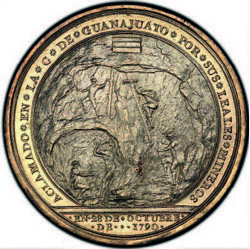 1. Three central stars reverse
1. Three central stars reverse
Previously catalogued as Grove C-75 and 77, Medina 166, Herrera 144 –Cayón 144ª, Rosa 113, Fonrobert 6824, and Pérez-Maldonado 107.
This reverse was the second and final design used in the Los Mineros medal.
The essential elements that identify it are located in the exergue legend and are the three central stars that separate the word “DE” and the date 1790.
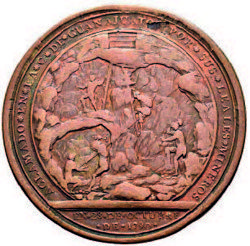 2. Star to the Center reverse
2. Star to the Center reverse
This has a single star in the center of the exegue.
Previously cataloged as Grove C-76 (first edition of 1970 and second edition of 1976) and 76.5 (second edition of 1976), Medina 167, Herrera uncataloged – Cayón 144, Rosa uncataloged, Fonrobert uncataloged, Betts Plate 4, No. 11.
This reverse was the first design for the Los Mineros medal.
There is no evidence of any medal with this design that does not present the transverse damage that goes from 2:00 to 7:00.
I have the hypothesis that the YNDIAS obverse (with pre-existing damage since the coinage of Puebla medals dated 17 January 1790), was related to the affectation suffered by this reverse.
The progression of the damage (die break across the reverse) was so fast that only a few Trial Strikes with the INDIAS obverse (the definitive obverse design) were made, and with the necessity to execute a second reverse, which was already detailed as the Three central stars reverse (the definitive reverse design).
Below you will find the two known Trial Strikes with the INDIAS obverse and Star to the Center reverse. Both were offered as with bronze module, pieces that are Trial Strikes, since, otherwise, in the performed research the number would have been more balanced between this combination and the definitive Issue.
Trial Strike Type III
INDIAS obverse , Star to the Center reverse
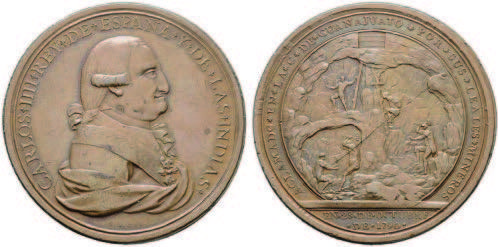
Cayón Subastas. Quick Auction 45 dated 29 November 2017, lot 8533, in which the cataloger noted well and described that the obverse corresponded to Grove C-75 and the reverse corresponded to Grove C-76.
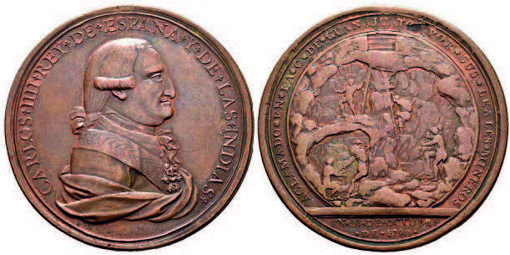
Tauler & Fau - Herrero. Auction 56 – Spring Special dated 29 April 2020, lot 633, in which the cataloger described the defect and/or damage of the reverse but only cataloged as H-144.
Hypothesis in the wear progression or damage of dies until the definitive issue
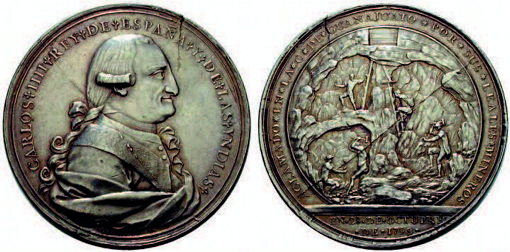
1. YNDIAS obverse, Star to the Center reverse. The collapse of the dies. Trial Strike Type I.
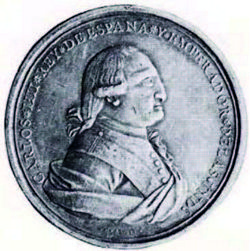
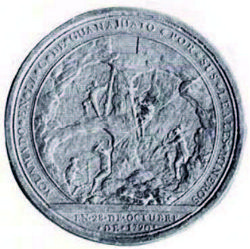
2.A. YNDsobverse, Star to the Center reverse. Selection of the new obverse bust among the existing ones while the reverse was made by reason of the affectation or damage. Trial Strike Type II.
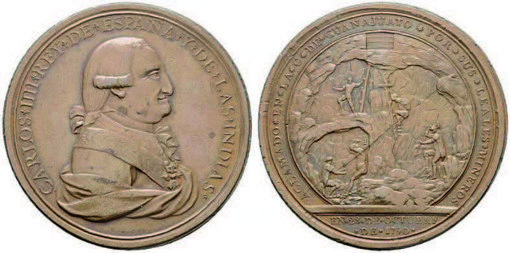
2.B. INDIAS obverse, Star to the Center reverse. Selection of the new obverse bust among the existing ones while the new reverse was made by reason of the affectation or damage. Trial Strike Type III.
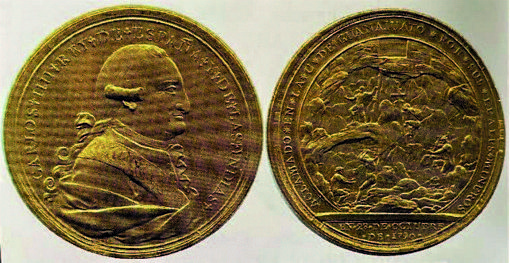
3. While the new reverse was made by reason of the affectation or damage, the Trial Strikes Type I, II and III are in approval process of the obverse. Silver, bronze (perhaps copper) and bronze, gold-plated medals were sent in order to review in all metals and finishes in which usually these medals are issued. Trial Strikes for Approval of the Bust.
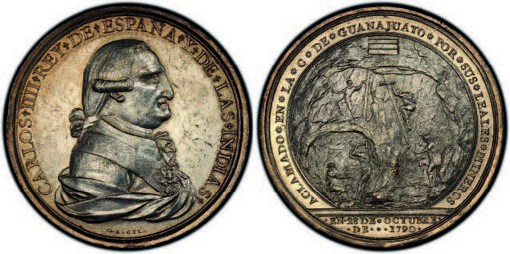
4. INDIAS obverse, Three central stars reverse, constituted the final designs for Los Mineros Guanajuato medal dated 28 October 1790. Definitive issue.
From the present investigation it is concluded that:
1.- Grove C-75 in its four versions, gold, silver (a), bronze, gold-plated (b) and bronze (c), constitute the definitive issue for this medal;
2.- Grove C-76, the medal that was later cataloged as C-76.5 as well as the unlisted C-75 obverse C-76 reverse, were trial strikes prior to the definitive issue. Existing trial strikes were made in bronze (perhaps copper), silver and bronze, gold-plated, of which two of the three previous proposed designs are known.
3.- This study did not include Grove C-77, which is also part of the Los Mineros issue. It is only to be said that the obverse was taken from a pre-existing medal, and the reverse corresponds to the Three central stars (the definitive reverse).
4.- During the development of this research, two really atypical pieces of a different nature were located. The first one that I will present is a very late issue, unlike the second one which is a very early issue. We will see why.
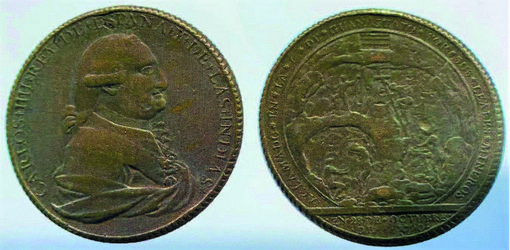
The first case corresponds to Grove C-75c (the definitive issue in bronze), struck on a planchet that I calculate to be a centimeter less than usual, that is to say 46 millimeters in diameter with the perculiarity that the reeded edge is very marked unlike the medals of this style of that time that are plain edge. There is no medal from that time in which the edge has that kind of reeded, so this piece is concluded as a restrike. This medal was offered by Alberto Hidalgo in his Auction No. 48 dated 18 October 2014, lot 405 and can be presumed as the only one known.
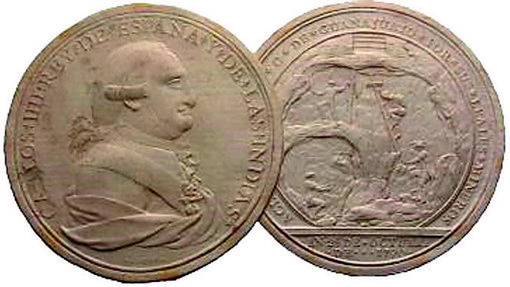
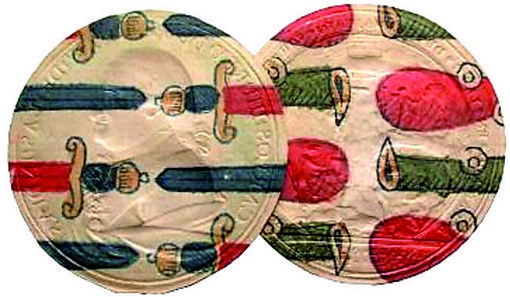
There are also imprints (where the dies have been pressed against some type of paper or cardboard), which were made on a Spanish deck of playing cards and are known from various proclamation medals. All of these imprints are from dies that are currently in the San Carlos Academy. These imprints were offered by Cayón Subastas at their auction dated 12 November 2006, lot 3265.
 My conclusion for this first case is that both the striking of the planchet and the imprints were carried out considerably after the definitive issue and by whover was holding the dies. The dies that make up the medal cataloged as Grove C-75 were received and belong to the Academia de San Carlos, University Heritage of the National Autonomous University of Mexico, UNAM. ...
My conclusion for this first case is that both the striking of the planchet and the imprints were carried out considerably after the definitive issue and by whover was holding the dies. The dies that make up the medal cataloged as Grove C-75 were received and belong to the Academia de San Carlos, University Heritage of the National Autonomous University of Mexico, UNAM. ...
The second case corresponds to a piece that shows the Three central stars reverse (the definitive reverse) and an obverse which I consider was prepared as the first option for the Los Mineros medal, which must have been done concomitantly to the Three central stars reverse as previously described, but failed in its execution in the following two aspects: the die fractured early at 7:00 and to the nape of the king’s bust; as they had already had a bad experience with the Star to the Center reverse, they did not hesitate to discard it and use one of those already made for previous medals. In addition, it seems that the legends were found to be poorly calculated in terms of size since the letter ‘S’ of the word ‘INDIAS’ was partially overlapped in the bust girdle, which ultimately removes quadrature and elegance to the design.
In my opinion, this confirms the urgency to complete the work that was entrusted to them and to issue the Los Mineros medal as soon as possible, - the reason why they were forced to select between one of the INDIAS, YNDIAS and YNDs obverses. If we placed the progression in the use of dies until the final issue in our hypothesis diagram, it would be between point number 2 and 3.
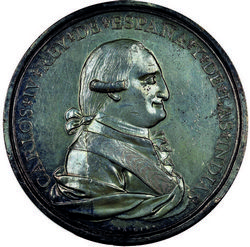 Each and every one of the obverse designs previously presented, describe the King as CARLOS IIII, the next obverse describes him as CARLOS IV. The reverse does not present a variant to the Three central stars reverse (the definitive reverse) so I only include the obverse. This piece was certified by NGC as MS 62, Grove C-75a (that is, INDIAS obverse with Three central stars reverse definitive issue - in silver) and was auctioned by Heritage Auctions on 27 October 2019, lot 39080, from the Dresden Collection of Hispanic and Brazilian Proclamation Medals. The NGC classification is not very precise, since the obverse does not correspond to the type described as Grove C-75a: at least the variety in the obverse should have been mentioned. Heritage Auctions also declined to comment on the misclassification given by NGC.
Each and every one of the obverse designs previously presented, describe the King as CARLOS IIII, the next obverse describes him as CARLOS IV. The reverse does not present a variant to the Three central stars reverse (the definitive reverse) so I only include the obverse. This piece was certified by NGC as MS 62, Grove C-75a (that is, INDIAS obverse with Three central stars reverse definitive issue - in silver) and was auctioned by Heritage Auctions on 27 October 2019, lot 39080, from the Dresden Collection of Hispanic and Brazilian Proclamation Medals. The NGC classification is not very precise, since the obverse does not correspond to the type described as Grove C-75a: at least the variety in the obverse should have been mentioned. Heritage Auctions also declined to comment on the misclassification given by NGC.
Obverse used for Grove C-77, Los Mineros, and on other medals.
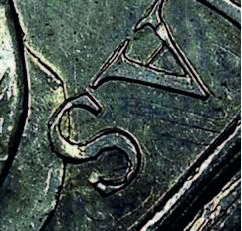
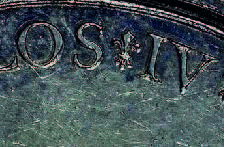

Overlapping S IV instead of IIII Rupture or failure along the side and up to the nape.
I can say that, after an exhaustive investigation into the Los Mineros medal, I can confirm the existence of a couple of authors who cataloged this piece, but unfortunately the fact was lost in the old books. García López in his 1905 work classified it as No. 287 ( page 202), but the first mention I could identify was Alejandro Rosa, in 1895, who described this piece in his book Aclamaciones de los Monarcas Católicos en el Nuevo Mundo, listed under the No. 115 (page 273). However, thee catalogs of Vidal Quadras, Fonrobert, as well as Herrera’s work, do not consider it.
I conclude with a table that classifies all the varieties and trial strikes for the Los Mineros medal:
| # | Los Mineros | Issue Type | Composition | Previous Classification |
Examples identified |
| 1 | Obverse INDIAS Reverse 3 central stars |
Definitive Issue | Gold | Grove C-75 | 2 |
| 2 | Obverse INDIAS Reverse 3 central stars |
Definitive Issue | Silver | Grove C-75a | 23 |
| 3 | Obverse INDIAS Reverse 3 central stars |
Definitive Issue | Bronze, Gold- Plated |
Grove C-75b | 3 |
| 4 | Obverse INDIAS Reverse 3 central stars |
Definitive Issue | Bronze | Grove C-75c | 18 |
| 4A | Obverse INDIAS Reverse 3 central stars |
Definitive Issue | Copper (Medina/Rosa) |
Grove C-76 UNCAT | 2 |
| 5 | Obverse YNDIAS Reverse Star to the Center |
Trial Strike TYPE I |
Bronze, Gold- Plated |
Grove C-76 | 2 |
| 6 | Obverse YNDIAS Reverse Star to the Center |
Trial Strike TYPE I |
Bronze (Medina) |
Grove C-76 | 1 |
| 6A | Obverse YNDIAS Reverse Star to the Center |
Trial Strike TYPE I |
Copper, Gold- Plated (Betts) |
Grove C-76 UNCAT | 0 |
| 6B | Obverse YNDIAS Reverse Star to the Center |
Trial Strike TYPE I |
Copper (Cayón) |
Grove C-76 UNCAT | 0 |
| 7 | Obverse YNDIAS Reverse Star to the Center |
Presentation Trial Strike TYPE I |
Silver | Grove C-76a | 3 |
| 8 | Obverse YNDs Reverse Star to the Center |
Trial Strike TYPE II |
Bronze | Grove C-76.5 | 1 |
| 9 | Obverse YNDs Reverse Star to the Center |
Trial Strike TYPE II |
Bronze, Gold- Plated |
Grove C-76.5 UNCAT | 0 |
| 10 | Obverse INDIAS Reverse Star to the Center |
Trial Strike TYPE III |
Bronze | Grove Anv C-75 Rev C-76 UNCAT |
2 |
| 11 | Obverse INDIAS Reverse Star to the Center |
Trial Strike TYPE III |
Bronze, Gold- Plated |
Grove Anv C-75 Rev C-76 UNCAT |
0 |
| 12 | Obverse INDIAS Reverse 3 central stars |
Subsequent Imprint | Spanish deck card | Grove C-75 VAR | 1 |
| 13 | Obverse INDIAS Reverse 3 central stars |
Restrike | Bronze Deep Corded Edge |
Grove C-75 VAR | 1 |
| 14 | Obverse Carlos IV Reverse 3 central stars |
Assay (failed) |
Silver Rosa No. 115 |
Grove Obv C-UNCAT Rev C-75 |
2 |
| 15 | To be determined | Trial Strike | Lead | To be determined | 0 |
| TOTAL | 61 |
Notes:
The medal cataloged by Grove as C-77 and those that could derive from the combination of Obverses and Reverses are excluded.
The copper medals are listed as sub issues, a the various authors could have confused them with bronze.
The column “EXAMPLES IDENTIFIED” could repeat medals verified in different books and/or auction catalogues. Where the numeral 0 is given, this means that it was listed but without a photograph.
There are specimens minted in lead, to be found in the Academia de San Carlos, but due to the present pandemic I could not research them The proclamation medals of the Spanish Kings in the New World, in connection with a diameter of 45 mm or more, could have weight variations of up to 12 grams. Keep in mind that these medals did not pursue the principle of circulating money, in which the intrinsic value (fineness and weight) does not exceed the circulation (or face) value. Weight variations do not mean restrikes or forgeries in this kind of medals, although it is true there are other medals of the period which have restrike specimens. In the particular case of the Los Mineros, I do not have evidence of counterfeit or restrike pieces, except for the one described as no. 13 of the preceding table. This abundant topic will already be the subject of another publication.
